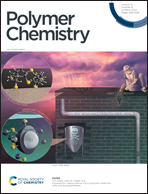Preparation of amphiphilic copolymers via base-catalyzed hydrolysis of quaternized poly[2-(dimethylamino)ethyl methacrylate]†
Abstract
The multi-stimuli-responsiveness of tertiary amine-containing polyacrylates makes them highly attractive for use in a wide range of applications. In the last decade, poly[2-(dimethylamino)ethyl methacrylate] (PDMAEMA) has received exceptionally great attention due to its versatility, accessibility, and biocompatibility. A process of quaternization of this polymer has already been widely established predominantly because quaternized PDMAEMA (qPDMAEMA) surfaces have been shown to possess an effective antibacterial activity. While studies on the hydrolytic stability of PDMAEMA can be found in the relevant literature, information about the hydrolysis of qPDMAEMA has been, to date, severely lacking. Here, we report the preparation of well-defined PDMAEMA via atom transfer radical polymerization (ATRP) and its partial and complete quaternization with iodomethane (CH3I). Our primary focus was on base-promoted hydrolysis; therefore over the course of two weeks, the reaction of PDMAEMA and three qPDMAEMA of different degrees of quaternization with a base in an aqueous medium was monitored by 1H NMR to obtain a comprehensive kinetic picture of hydrolysis. It was found that under mild conditions (25 °C, 0.25 M NaOD concentration), qPDMAEMA side groups slowly degrade to poly[methacrylic acid] (PMAA), meaning that via consecutive quaternization and hydrolysis, a large variety of desired, cationic, anionic, and zwitterionic copolymers can be synthesized with precise control. We showed that highly stable to hydrolysis PDMAEMA after transformation into qPDMAEMA can be easily hydrolyzed in an alkaline solution, and that opens an alternative, simple, and highly controllable way of preparation of PMAA. The rate and the degree of degradation of quaternized repeating units are dependent on their amount in the copolymer chains. A drastic difference between PDMAEMA and qPDMAEMA in terms of sensitivity to hydrolysis and unexpected rates of this reaction were suspected to be caused by the intramolecular interactions within the side groups and by electrostatic interactions, respectively.
![Graphical abstract: Preparation of amphiphilic copolymers via base-catalyzed hydrolysis of quaternized poly[2-(dimethylamino)ethyl methacrylate]](/en/Image/Get?imageInfo.ImageType=GA&imageInfo.ImageIdentifier.ManuscriptID=D1PY01697K&imageInfo.ImageIdentifier.Year=2022)


 Please wait while we load your content...
Please wait while we load your content...